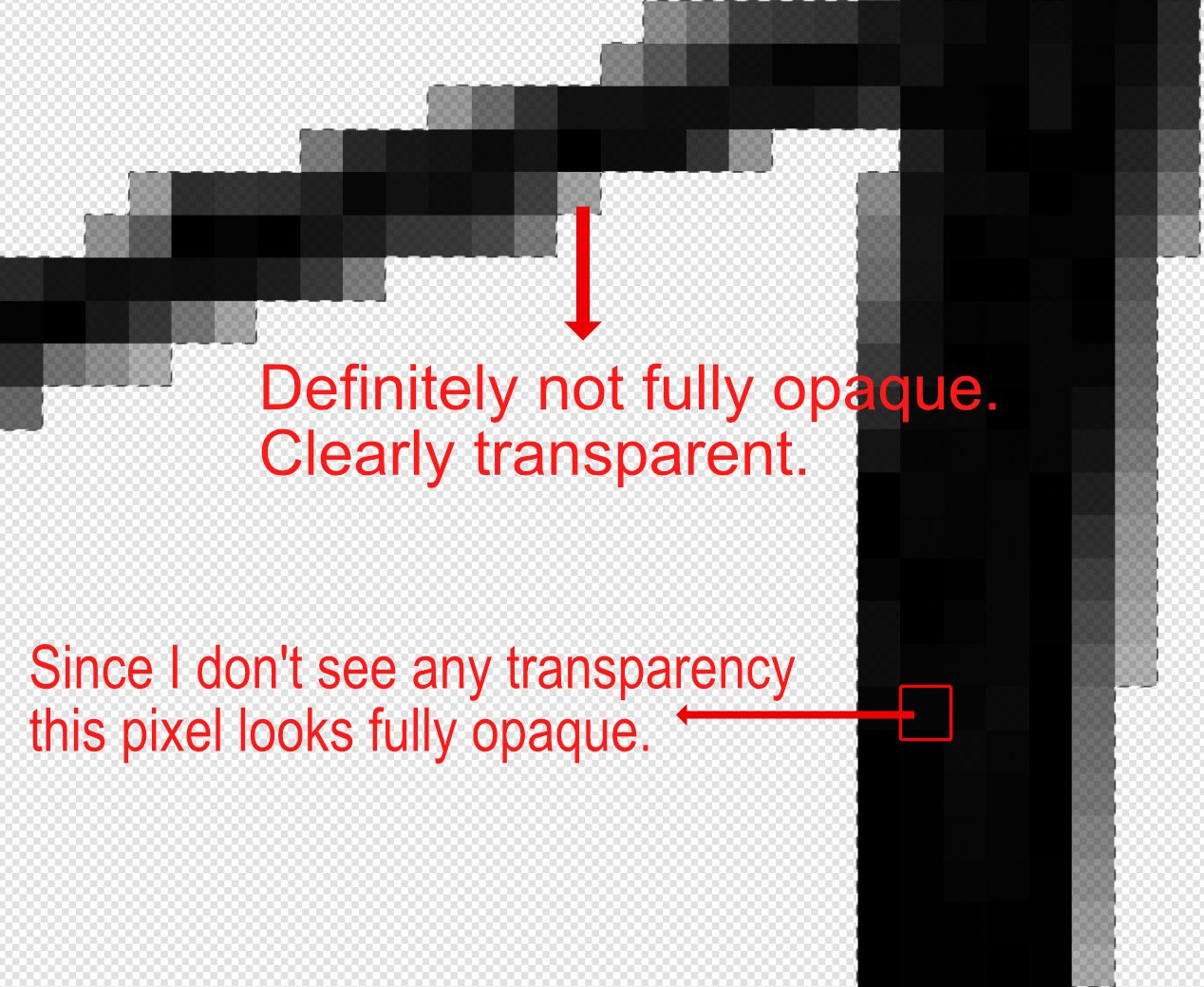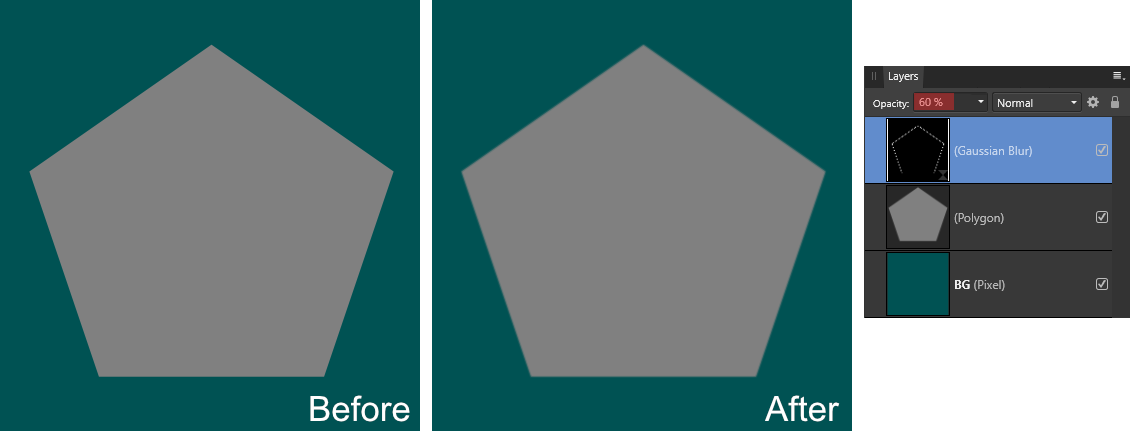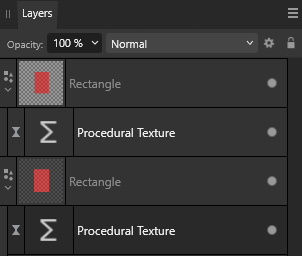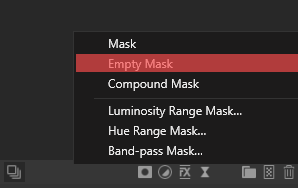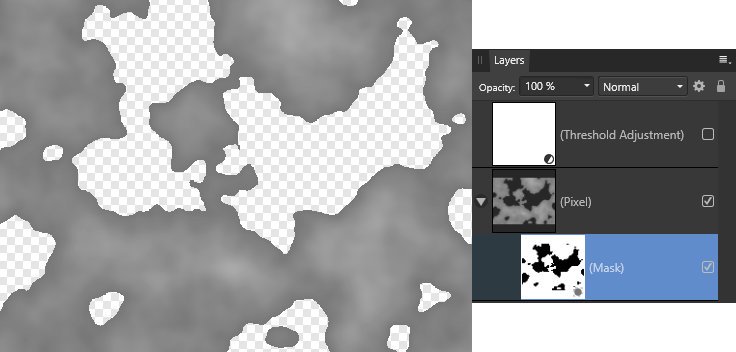
Lisbon
Members-
Posts
397 -
Joined
-
Last visited
Everything posted by Lisbon
-
Hi @keithrt I don't know if it helps, but procedural textures (PT) come with the sine function and with a few adjustments you can actually get sine waves. Just play with the PT and gradient map. Avoid changing group content. Download at the end. Example: SineWave.afphoto
-
Hi @mardymarvin I use A.Photo v1 but I think that won't be a problem. I assume you are referring to the Flood Select Tool [W], right? Since in your example the pixels have very different opacities, we can be led to think that gray tones are being selected. The only way to be sure is to open the info panel and measure some pixels. As you mentioned, with the tolerance set to 0%, all selected RGB values must be the same. In the case of black RGB = 0 0 0 If they are different then we may have a problem. Is it possible that you are trying to select fully opaque black pixels?
-
how can i get these smooth edges?
Lisbon replied to RetroDesire's topic in Affinity on Desktop Questions (macOS and Windows)
"how can i get these smooth edges?" By blurring them. Here is one way. Start by loading the shape/layer as a selection (Ctrl + Mouse click on the layers thumbnail) Convert the edge selection into an outline (Select > Outline / Radius=2px) Finally, add a live Gaussian blur (Radius=1px) Note that I have reduced the opacity of the blur. This helped the shape blend in better instead of just looking blurry around the edges. The most important thing is to get an edge selection. Affinity Photo v2 allows band pass masks. I've never actually used it, but I think it might work. -
Don't get me wrong, I'm all for consistency. Brightness and contrast by default works in a non-linear way, but in the Develop persona it is linear. Should I report this as a bug?! What I'm saying is that I suspect the fixed grid was intentional hence my suggestion for a feature request. Maybe i'll do the same for Brightness and contrast in Develop Persona 😀
-
I see. I think you should make a feature request because i think that this fixed grid attached to the document is intencionial by design.
-
Voronoi works with a fixed grid. You can test this with two different images with exactly the same dimensions. Let's assume that the color of each cell is determined based on the average of the pixels of the original image. So if the grid is fixed and you change the position of the original image, the pixel average for each cell will be different.
-
Thank you @Ldina Very useful. ---###--- Many of the adjustments in Develop Persona are linear. Brightness & Contrast for example. Notice that in Photo Persona the Linear option is unchecked by default. It's the same in Photoshop and it works that way at least since CS3 (2007). For most cases it is a bad idea to make the adjustments linear. I wonder if expensive Raw Developers like Capture One work the same way.
- 10 replies
-
- affinity photo
- photo persona
-
(and 2 more)
Tagged with:
-
Hi @stokerg This was intentional on my part. Just to show on how Procedural Textures (PT) affect according to their current position. Personally I know how to work around the problem as I demonstrated in the video. But in the specific case of rectangles like in the @Zero1 example I don't think the area around it should be replaced by some color. I think that there isn't supposed to be anything around shapes. When I say nothing I am including RGB+A data. If that were the case the surrounding arround the rectangle would never be replaced by 50% opacity black. Regardless of whether I drop the PT filter in the right position or not. (The bottom PT filter is in the wrong position - Transparency arround rectangle replaced by 50% opac. black)
-
Tech specs for newbies
Lisbon replied to DrJon's topic in Affinity on Desktop Questions (macOS and Windows)
Are you including adjustment layers? I always had the idea that adjustment layers were very simple compared to, say... adjustments within raw developers. Wouldn't that affect greatly the performance after a few adjustments if they were performing complex operations on the background? I agree. And with very nice results i must say. This screenshot, refers to A.Photo right? I only ask because in Photoshop, the saturation slider within the vibrance adjustment also affects reds differently. -
Agree 100%. Undoubtedly, Photoshop has tools that A.Photo does not have. What I question is the quality of the results compared to this generation of AI software. I don't know if things have improved, but "shake reduction" used to leave a lot of wavy patterns in the image.
- 5 replies
-
- blur
- motion blur
-
(and 2 more)
Tagged with:
-
Tech specs for newbies
Lisbon replied to DrJon's topic in Affinity on Desktop Questions (macOS and Windows)
I find it quite interesting how vibrance works. Low saturated colors get an extra boost in saturation compared to already highly saturated colors. But this extra protection on the reds i dont understand why. I admit that it can be useful when there are skin tones but not all images have skin tones. Photoshop works the same. -
masks. what am i doing wrong?
Lisbon replied to maxegb's topic in Affinity on Desktop Questions (macOS and Windows)
Same with me in version 2. No problems with A.Photo v1. (A.Photo 2.04 MSI / Win 10) -
That changes everything. While they solve the problem use this macro (Download at the end). See if this works on Mac: 1) Run the macro 2) Adjust the Gaussian Blur and Merge with the "Low Freq." layer 3) Turn the Visibility On of the "High Freq." group and rasterize the group Frequency Separation.afmacros
-
Hi @jportraits Im a windows user. I don't know if I understood correctly but are you saying that you don't have any problems if you use Live Gaussian Blur?
-
Are you a genius? 😀 Is it true that Photopea is less than 2MB? Great job Ivan.
- 11 replies
-
- affinity photo
- psd files
-
(and 1 more)
Tagged with:
-
Both "shake reduction" and "smart sharpen" use deconvolution (some crazy math running on the background). "shake reduction" can estimate both direction and amount of blur. As far as I know this is not possible in A.Photo and even if it were possible deconvolution would not be my first choice. I've seen AI software with very good results removing motion blur. From Topaz, I think. But dont get your expectations to high. Motion Blur is one of the hardest problems to fix.
- 5 replies
-
- blur
- motion blur
-
(and 2 more)
Tagged with:
-
Masked Groups in V2 Photo
Lisbon replied to rangerpaul's topic in Affinity on Desktop Questions (macOS and Windows)
If I mistakenly click on the group instead of the mask before inverting (Ctrl+I), it will rasterize the group, resulting in a transparent pixel layer. Rather than adding a mask + inverting the colors, I suggest adding a negative mask in one single step. If you prefer, you can assign a shortcut: Edit > Preferences > Shortcuts > Photo/Layer: New Empty Mask Layer -
The first thing I do is check if there are actually details to recover. This saves me a lot of time. If you add a curves adjustment set to multiply and duplicate this adjustment 3 times this is is the result. As you can see there is not enough detail that can be retrieved. The background remains white and many parts are missing. When this happens, i usually replace the background with something else. Ideally, use another photo taken at the same location.
-
Hard to say. The problem with effects is that most of the time we can only try to guess. Looking at your image it looks like perlin noise or some variation of it. Fill a layer with perlin noise. Next create a mask so that you have hard edges: a) Add a threshold adjustment b) Load one of the RGB channels as a selection c) Add a mask to your perlin noise layer d) Disable the threshold adjustment Finally give your perlin noise layer some color. I used a gradient map and HSL adjustment.




